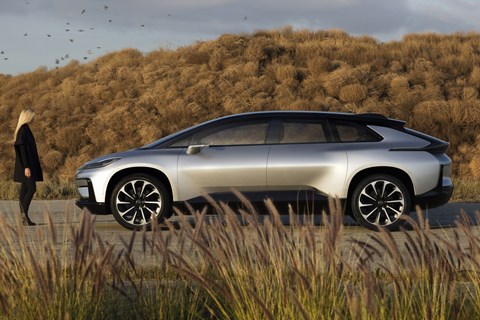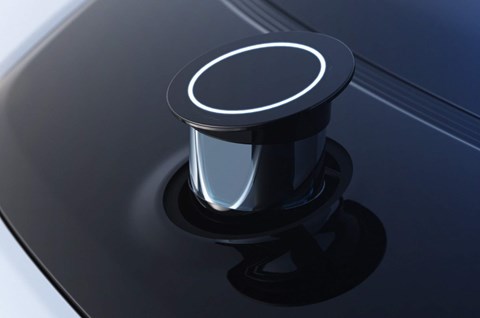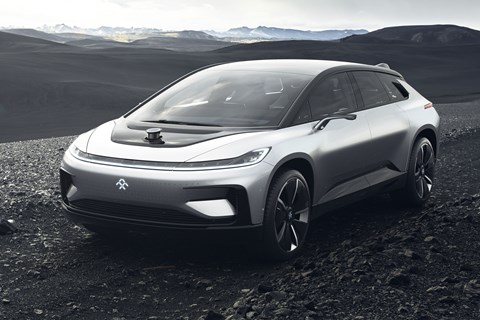► Four-door saloon from Faraday Future packs 1000bhp+
► Production of new FF 91 scheduled to start in 2018
► Myriad tech highlights, including facial recognition
Start-up EV specialist firm Faraday Future has previewed its first production car ahead of the 2017 Consumer Electronics Show (CES) in Las Vegas.
The new car, called the Faraday Future FF 91, is claimed to be capable of 0-60mph in 2.39sec – potentially making it the quickest electric car in production. It’s scheduled to be launched in 2018, with deposits being taken for pre-orders now.
Faraday Future FF 91: the stats
- Peak motor power of 783kW (equivalent to 1050 metric horsepower)
- A 130kWh battery system, supplied by LG Chem
- A 435-mile driving range (NEDC) from a full charge
- Approximately 4.5 hours to charge the battery from 50% to full, using a 240V home charger system included in the purchase of the car
- 0-60mph in 2.39sec – making the FF91 quicker than Tesla’s fastest Model S variant

Design
The FF 91 is a high-riding, tall-bodied four-door saloon that’s built around a modular monocoque platform. Dubbed Variable Platform Architecture (VPA), it’s capable of several potential battery and motor configurations. The FF91 drives all four wheels with multiple motors, and features rear-wheel steering.
A long wheelbase aids interior space, and the FF 91’s rear seats are claimed to recline further than those of any current production cars.
Exterior ‘communication’ lighting welcomes the driver with lights that brighten as they approach, and change pattern to let other road users know when the car is in autonomous mode.
Autonomous mode?
Yes, the FF 91 unsurprisingly features self-driving modes, including ‘driverless valet’, whereby the driver can leave the car to park itself. At the CES unveil, a demonstration showed the FF 91 driving itself around a car park and parking itself in a space, however, in an attempt to demonstrate the system on stage it refused to play ball.

It sounds like an awfully complicated car…
There’s more. The Faraday Future FF 91 is designed to be used without a key, with a facial recognition system via a camera on the B-pillar granting drivers and passengers entry. The doors open electrically, with sensors to prevent them bumping into things.
An interior cameras also ogles occupants, activating pre-set interior settings upon recognising them. Faraday Future also suggests the cameras can recognise facial expressions and moods to ‘auto-prompt an experience to match, using music, temperature, scent, content, massage and more.’
Antennas help the car receive and process data, with users encouraged to connect to the car via a ‘FFID’ account, and share route plans, media and other data remotely, with the car remembering seating positions, music and movies, climate control settings and so on when they next climb aboard. A variety of active safety systems include 10 HD cameras, long and short range radars and further sensors.

The FF 91’s appropriately full of tech for a car revealed at CES, then. How many of those capabilities will be simplified for production – and, indeed, whether the car makes it to production on schedule and in the same form – we’ll have to wait and see.
What is Faraday Future?
An automotive ‘mobility company’ with headquarters in southern California. Investors include Chinese smartphone and video specialist LeEco, which powers the FFID system.
Since Faraday Future unveiled its dramatic FFZERO1 concept at CES 2016, it has encountered widely reported financial difficulties. Work on its new factory in Las Vegas was halted by the company constructing it, reputedly over unpaid invoices.
Multiple key management figures, including acting CEO Ding Lei and ex-Ferrari North America chief Marco Mattiacci, reportedly left the company in December 2016.
‘Despite all the naysayers and the sceptics we will persist,’ said Faraday Future’s senior vice president Nick Sampson at the FF 91’s launch.
Read more CAR tech news